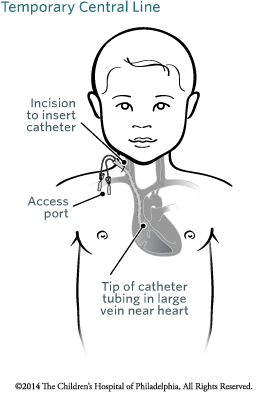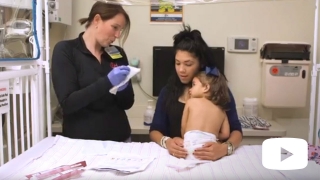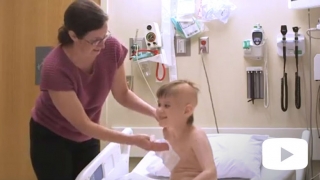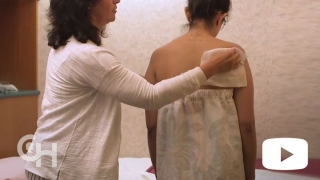Temporary Central Line
What is a temporary central line?
A temporary central line is a short-term catheter placed in a vein, either in the neck (the internal jugular vein) or, less commonly, the groin (the femoral vein). Generally a temporary central line is in place for less than two weeks.

Most commonly a temporary central line is placed for dialysis (blood filtration to remove chemicals and waste) or pheresis (separation of blood components, usually to obtain stem cells). These therapies require a special catheter to process the blood correctly. The end of the catheter (called the hub or clave) is outside the skin and the nurse will use that to access the vein, rather than having to place an IV each time.
How is a temporary central line inserted?
Using ultrasound and live X-ray (fluoroscopy) for guidance, the doctor will insert a special hollow needle into the vein. The catheter will be inserted through the needle, threaded through the vein and positioned so the tip of the catheter is in the large vein that carries blood into the heart.
A small portion of the catheter remains outside the skin and is stitched (sutured) to the skin in order to secure it.
Your child will be protected by an X-ray shield during the procedure.
Will my child be awake during the procedure?
No. We will use either IV sedation or general anesthesia so that your child isn’t awake.
How long does the procedure take?
Approximately one hour.
What risks are associated with this procedure?
The procedure is considered low-risk. However, potential complications include:
- Bleeding
- Infection
- Puncture of adjacent structures, such as other veins
- Air embolism (air in the veins)
- Collapse of the lung (pneumothorax)
- Bleeding into the chest (hemothorax)
- Catheter breakage (upon removal)
Will my child be in any pain after the procedure?
The insertion site may be tender for several days.
May I remove the bandage over the catheter?
Do not remove the bandage. It must remain clean and dry at all times. We will give you instructions on what to do if the bandage becomes loose.
Are there any activity restrictions?
Your child will have to avoid activities, such as contact sports and rough playing that may result in a pull to the catheter. If you have questions about which activities are OK, please ask us.
When can my child bathe after the catheter is placed?
While the line is in place, you may sponge bathe your child. The line must stay dry at all times.
How is a temporary central line removed?
The catheter can be removed easily and quickly, usually without the need to sedate your child. We will remove the bandage, cut the stitches and pull out the line. We will apply pressure to the site, to minimize the risk of bleeding, and then apply a fresh bandage.
When can I take off the bandage after the catheter removal?
After 48 hours, you may remove the clear bandage and gauze. Some children will have Steri-Strips® (white strips) under the gauze. Allow them to curl up and fall off on their own. If they haven’t fallen off after seven days, you may remove them.
When can my child bathe after the catheter is removed?
Once you remove the bandage, your child may take a bath or shower. Until the Steri-Strips fall off, do not allow water from the shower to hit the site directly and do not submerge the site underwater (bath or pool).


